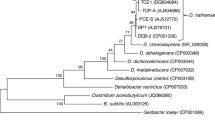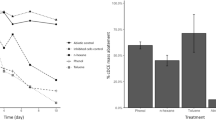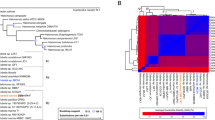Abstract
Strain KBC1, an anaerobic bacterium, that dechlorinates tetrachloroethene (PCE) to trichloroethene was isolated. This strain also dechlorinated high concentrations of PCE at a temperature range of 10 to 40°C and showed high oxygen tolerance. Based on the 16S rRNA gene sequence analysis, this microorganism was identified as a species of the genus Desulfitobacterium. Several species of this genus have been reported to be potent ortho-chlorophenol and PCE dechlorinators; however, the gene coding PCE-specific dehalogenase had not been cloned thus far. In this report, we identified a novel PCE reductive dehalogenase (PrdA) gene from the Desulfitobacterium sp. strain KBC1. These prd genes, including putative membrane anchor protein, were classified as novel type of PCE reductive dehalogenase (approximately 40% homology with the general PCE dehalogenase). It was revealed that the two open reading frames had been transcribed as identical mRNA and were induced strictly in the presence of PCE. This transcriptional regulation appeared to be controlled by the transcriptional activator located downstream of prdAB operon. According to the substrate utility of the strain KBC1 and phylogenetic analysis of PrdA, this microorganism may be expected to play the role of a primary dechlorinator of PCE in the environment.







Similar content being viewed by others
References
Adrian L, Szewzyk U, Wecke J, Gorisch H (2000) Bacterial dehalorespiration with chlorinated benzenes. Nature 408:580–583
Bradford MM (1976) A rapid and sensitive method for the quantitation of microgram quantities of protein utilizing the principle of protein-dye binding. Anal Biochem 72:248–254
Chomczynski P (1992) One-hour downward alkaline capillary transfer for blotting of DNA and RNA. Anal Biochem 201:134–139
de Best JH (1999) Anaerobic transformation of chlorinated hydrocarbons in a packed-bed reactor. Ph.D. thesis (February 8), University of Groningen
Dos Santos WG, Pacheco I, Liu MY, Teixeira M, Xavier AV, LeGall J (2000) Purification and characterization of an iron superoxide dismutase and a catalase from the sulfate-reducing bacterium Desulfovibrio gigas. J Bacteriol 182:796–804
Fennell DE, Nijenhuis I, Wilson SF, Zinder SH, Haggblom MM (2004) Dehalococcoides ethenogenes strain 195 reductively dechlorinates diverse chlorinated aromatic pollutants. Environ Sci Technol 38:2075–2081
Fogel MM, Taddeo AR, Fogel S (1986) Biodegradation of chlorinated ethenes by a methane-utilizing mixed culture. Appl Environ Microbiol 51:720–724
Gerritse J, Renard V, Pedro Gomes TM, Lawson PA, Collins MD, Gottschal JC (1996) Desulfitobacterium sp. strain PCE1, an anaerobic bacterium that can grow by reductive dechlorination of tetrachloroethene or ortho-chlorinated phenols. Arch Microbiol 165:132–140
Gerritse J, Kloetstra G, Borger A, Dalstra G, Alphenaar A, Gottschal JC (1997) Complete degradation of tetrachloroethene in coupled anoxic and oxic chemostats. Appl Microbiol Biotechnol 48:553–562
He J, Ritalahti KM, Aiello MR, Loffler FE (2003a) Complete detoxification of vinyl chloride by an anaerobic enrichment culture and identification of the reductively dechlorinating population as a Dehalococcoides species. Appl Environ Microbiol 69:996–1003
He J, Ritalahti KM, Yang KL, Koenigsberg SS, Loffler FE (2003b) Detoxification of vinyl chloride to ethene coupled to growth of an anaerobic bacterium. Nature 424:62–65
Holscher T, Krajmalnik-Brown R, Ritalahti KM, Von Wintzingerode F, Gorisch H, Loffler FE, Adrian L (2004) Multiple nonidentical reductive-dehalogenase-homologous genes are common in Dehalococcoides. Appl Environ Microbiol 70:5290–5297
Katayama-Fujimura Y, Komatsu Y, Kuraishi H, Kaneko T (1984) Estimation of DNA base composition by high performance liquid chromatography of its nuclease P1 hydrolysate. Agric Biol Chem 48:3169–3172
Kato C, Smorawinska M, Sato T, Horikoshi K (1995) Cloning and expression in Escherichia coli of a pressure-regulated promoter region from a barophilic bacterium, strain DB6705. J Mar Biotechnol 2:125–129
Little CD, Palumbo AV, Herbes SE, Lidstrom ME, Tyndall RL, Gilmer PJ (1988) Trichloroethylene biodegradation by a methane-oxidizing bacterium. Appl Environ Microbiol 54:951–956
Magnuson JK, Stern RV, Gossett JM, Zinder SH, Burris DR (1998) Reductive dechlorination of tetrachloroethene to ethene by a two-component enzyme pathway. Appl Environ Microbiol 64:1270–1275
Magnuson JK, Romine MF, Burris DR, Kingsley MT (2000) Trichloroethene reductive dehalogenase from Dehalococcoides ethenogenes: sequence of tceA and substrate range characterization. Appl Environ Microbiol 66:5141–5147
Maillard J, Schumacher W, Vazquez F, Regeard C, Hagen WR, Holliger C (2003) Characterization of the corrinoid iron–sulfur protein tetrachloroethene reductive dehalogenase of Dehalobacter restrictus. Appl Environ Microbiol 69:4628–4638
Maymo-Gatell X, Chien Y, Gossett JM, Zinder SH (1997) Isolation of a bacterium that reductively dechlorinates tetrachloroethene to ethene. Science 276:1568–1571
Maymo-Gatell X, Anguish T, Zinder SH (1999) Reductive dechlorination of chlorinated ethenes and 1,2-dichloroethane by “Dehalococcoides ethenogenes” 195. Appl Environ Microbiol 65:3108–3113
Mesbah M, Whitman WB (1989) Measurement of deoxyguanosine/thymidine ratios in complex mixtures by high-performance liquid chromatography for determination of the mole percentage guanine+cytosine of DNA. J Chromatogr 479:297–306
Miller E, Wohlfarth G, Diekert G (1998) Purification and characterization of the tetrachloroethene reductive dehalogenase of strain PCE-S. Arch Microbiol 169:497–502
Mohn WW, Tiedje JM (1992) Microbial reductive dehalogenation. Microbiol Rev 56:482–507
Muller JA, Rosner BM, Von Abendroth G, Meshulam-Simon G, McCarty PL, Spormann AM (2004) Molecular identification of the catabolic vinyl chloride reductase from Dehalococcoides sp. strain VS and its environmental distribution. Appl Environ Microbiol 70:4880–4888
Neumann A, Wohlfarth G, Diekert G (1996) Purification and characterization of tetrachloroethene reductive dehalogenase from Dehalospirillum multivorans. J Biol Chem 271:16515–16519
Neumann A, Wohlfarth G, Diekert G (1998) Tetrachloroethene dehalogenase from Dehalospirillum multivorans: cloning, sequencing of the encoding genes, and expression of the pceA gene in Escherichia coli. J Bacteriol 180:4140–4145
Neumann A, Siebert A, Trescher T, Reinhardt S, Wohlfarth G, Diekert G (2002) Tetrachloroethene reductive dehalogenase of Dehalospirillum multivorans: substrate specificity of the native enzyme and its corrinoid cofactor. Arch Microbiol 177:420–426
Odom JM, Peck HD Jr (1981) Hydrogen cycling as a general mechanism for energy coupling in the sulfate-reducing bacteria Desulfovibrio sp. FEMS Microbiol Lett 12:47–50
Pop SM, Kolarik RJ, Ragsdale SW (2004) Regulation of anaerobic dehalorespiration by the transcriptional activator CprK. J Biol Chem 279:49910–49918
Sanger F, Nicklen S, Coulson AR (1977) DNA sequencing with chain-terminating inhibitors. Proc Natl Acad Sci U S A 74:5463–5467
Seshadri R, Adrian L, Fouts DE, Eisen JA, Phillippy AM, Methe BA, Ward NL, Nelson WC, Deboy RT, Khouri HM, Kolonay JF, Dodson RJ, Daugherty SC, Brinkac LM, Sullivan SA, Madupu R, Nelson KE, Kang KH, Impraim M, Tran K, Robinson JM, Forberger HA, Fraser CM, Zinder SH, Heidelberg JF (2005) Genome sequence of the PCE-dechlorinating bacterium Dehalococcoides ethenogenes. Science 307:105–108
Smidt H, van Leest M, van der Oost J, de Vos WM (2000) Transcriptional regulation of the cpr gene cluster in ortho-chlorophenol-respiring Desulfitobacterium dehalogenans. J Bacteriol 182:5683–5691
Suyama A, Yamashita M, Yoshino S, Furukawa K (2002) Molecular characterization of the PceA reductive dehalogenase of Desulfitobacterium sp. strain Y51. J Bacteriol 184:3419–3425
Utkin I, Woese C, Wiegel J (1994) Isolation and characterization of Desulfitobacterium dehalogenans gen. nov., sp. nov., an anaerobic bacterium which reductively dechlorinates chlorophenolic compounds. Int J Syst Bacteriol 44:612–619
van de Pas BA, Smidt H, Hagen WR, van der Oost J, Schraa G, Stams AJ, de Vos WM (1999) Purification and molecular characterization of ortho-chlorophenol reductive dehalogenase, a key enzyme of halorespiration in Desulfitobacterium dehalogenans. J Biol Chem 274:20287–20292
van de Pas BA, Gerritse J, de Vos WM, Schraa G, Stams AJ (2001) Two distinct enzyme systems are responsible for tetrachloroethene and chlorophenol reductive dehalogenation in Desulfitobacterium strain PCE1. Arch Microbiol 176:165–169
Villemur R, Saucier M, Gauthier A, Beaudet R (2002) Occurrence of several genes encoding putative reductive dehalogenases in Desulfitobacterium hafniense/frappieri and Dehalococcoides ethenogenes. Can J Microbiol 48:697–706
Vogel TM, Criddle CS, McCarty PL (1987) Transformation aliphatic compounds. Environ Sci Technol 21:722–736
Voordouw G (1995) The genus Desulfovibrio: the centennial. Appl Environ Microbiol 61:2813–2819
Voordouw G (2000) A universal system for the transport of redox proteins: early roots and latest developments. Biophys Chemist 86:131–140
Wackett LP, Gibson DT (1988) Degradation of trichloroethylene by toluene dioxygenase in whole-cell studies with Pseudomonas putida F1. Appl Environ Microbiol 54:1703–1708
Zehnder AJ, Wuhrmann K (1976) Titanium (III) citrate as a nontoxic oxidation-reduction buffering system for the culture of obligate anaerobes. Science 194:1165–1166
Zhang H, Hanada S, Shigematsu T, Shibuya K, Kamagata Y, Kanagawa T, Kurane R (2000) Burkholderia kururiensis sp. nov., a trichloroethylene (TCE)-degrading bacterium isolated from an aquifer polluted with TCE. Int J Syst Evol Microbiol 50(Pt 2):743–749
Acknowledgements
We thank Yoichi Kamagata and Naoya Shinzato (National Institute of Advanced Industrial Science and Technology) for advice on isolation of strain KBC1.
This study was carried out as a part of “The Project for Development of Technologies for Analyzing and Controlling the Mechanism of Biodegrading and Processing,” which was entrusted by the New Energy and Industrial Technology Development Organization (NEDO).
Author information
Authors and Affiliations
Corresponding author
Electronic Supplementary Material
Rights and permissions
About this article
Cite this article
Tsukagoshi, N., Ezaki, S., Uenaka, T. et al. Isolation and transcriptional analysis of novel tetrachloroethene reductive dehalogenase gene from Desulfitobacterium sp. strain KBC1. Appl Microbiol Biotechnol 69, 543–553 (2006). https://doi.org/10.1007/s00253-005-0022-x
Received:
Revised:
Accepted:
Published:
Issue Date:
DOI: https://doi.org/10.1007/s00253-005-0022-x




